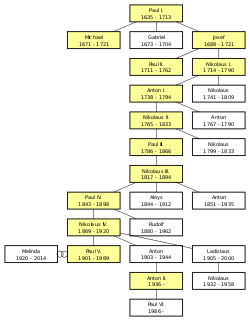Paul I. Esterházy de Galantha
Count, later Prince Paul (or Pal) I. Esterházy de Galantha (born September 8, 1635 in Eisenstadt in Burgenland ; † March 26, 1713 ibid) was Imperial Field Marshal and first prince of the Esterházy family .
Life
His first marriage was the son of Count Nikolaus Esterházy with his niece Countess Ursula Esterházy. After her death, although the Esterházys were always loyal to the emperor, he married Eva Thököly von Kesmark . Those von Kesmarks were long-established Hungarian magnates and haters of emperors. Paul completed his studies with the Jesuits in Trnava (Tyrnau) and Graz and inherited the great fortune of the family in 1652 after his older brother Count Ladislaus Esterházy had been killed in the war against the Turks.
He himself began his military career only from 1664, when he opposed the Turks in the battle of Mogersdorf under Raimund von Montecuccoli . In 1671 he took in around 3,000 Jews who had been expelled from Vienna by Emperor Leopold I. This led to the foundation of the seven communities in Burgenland. Because of his services in the following years, Paul was appointed field marshal and commander in chief of the military border of southern Hungary. Paul remained loyal to the Habsburgs throughout his life and therefore did not take part in the conspiracy of the Hungarian nobility in the 1770s. This loyalty was rewarded by the Habsburgs, who appointed him Palatine in 1681 . Nevertheless, the Turkish wars did not leave the Esterházy family unaffected, because numerous territories of the family were devastated by the advance of the Turks into Vienna and the population that lived there was partially slaughtered.
Paul took part in the reconquest of Hungary and was elevated to the rank of prince by the emperor in 1687. This title was initially only "ad personam", i. H. limited to him personally. From 1712 the eldest son was also allowed to hold the title of prince. In 1703 he fought again for the Habsburgs in the Kuruc Wars . After his death in 1713 he was buried in the family crypt in the Franciscan monastery in Eisenstadt. To secure his fortune, he founded after Habsburg Prototype Fideikommiss and settled his successor in his will through the establishment of two primogeniture for his sons Michael and Joseph . However, since both sons died soon after their father, the two majorates were reunited a short time later.
Paul Esterházy played the harpsichord himself and composed. His Harmonia Caelestis for voices and orchestra was published in Vienna in 1711.
literature
- Wilhelm Edler von Janko : Esterhazy von Galántha, Paul Fürst . In: Allgemeine Deutsche Biographie (ADB). Volume 6, Duncker & Humblot, Leipzig 1877, p. 387 f.
- Johann Christoph Allmayer-Beck : Esterházy von Galántha, Paul Graf. In: New German Biography (NDB). Volume 4, Duncker & Humblot, Berlin 1959, ISBN 3-428-00185-0 , p. 662 f. ( Digitized version ).
Web links
- Entry about Paul I. Esterházy de Galantha in the Hungarian Biographical Lexicon (MEK) of the National Széchényi Library (Hungarian)
- Works by and about Paul I. Esterházy de Galantha in the German Digital Library
- Entry on Paul I. Esterházy de Galantha in the Austria Forum (in the AEIOU Austria Lexicon )
- Prince Paul I (1635–1713) in the private homepage of Esterházy Betriebe GmbH
Individual evidence
- ↑ www.aeiou.at Paul I. Prince Esterhàzy Accessed on June 3, 2012
| predecessor | Office | successor |
|---|---|---|
| Ladislaus |
Majorate ruler of the Esterházy family 1652–1713 |
Michael I. |
|
Franz Wesselényi von Hadad (1668–1680 the post remained vacant) |
Palatine of Hungary 1681–1713 |
Nikolaus Pálffy von Erdöd |
| personal data | |
|---|---|
| SURNAME | Esterházy de Galantha, Paul I. |
| ALTERNATIVE NAMES | Esterházy, Paul I. Prince |
| BRIEF DESCRIPTION | imperial field marshal |
| DATE OF BIRTH | September 8, 1635 |
| PLACE OF BIRTH | Eisenstadt |
| DATE OF DEATH | March 26, 1713 |
| Place of death | Eisenstadt |

